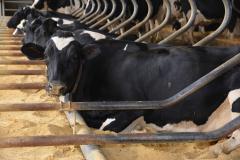Preventing Mastitis Starts with Proper Management of Stall Bedding
Preventing Mastitis Starts with Proper Management of Stall Bedding

The old saying goes “An ounce of prevention is worth a pound of cure”, and that could not be more true for the prevention of mastitis. Pathogens picked up from the environment are a major cause of mastitis, in both clinical and subclinical cases. Cows contract mastitis from environmental pathogens present in bedding when the teat ends come in contact with contaminated bedding, mud, or manure. Mastitis prevention is multifaceted, but is influenced by housing decisions, especially as it relates to the choice of bedding and daily maintenance of these surfaces. The prevention of mastitis in freestall and tiestall barns is largely related to the bedding type and depth and stall surface maintenance.
Bedding Must Be Managed By Type
Sand: Sand has long been the gold standard for deep-bedded freestall barns, with good reason. Sand is an inorganic bedding material, making it less appealing as a home for bacteria. When compared to straw, sawdust, or manure solids, cows bedded with sand have a lower incidence of hock and knee injuries, better overall hoof health, and have longer lying times. However, sand requires specialized equipment and management. Sand is notorious for being tough on equipment and difficult to manage in the lagoon. If it is not recycled, it settles to the bottom of the lagoon and will decrease the lagoon capacity for manure. The lagoon will also have to be cleaned out to remove the sand. The alternative is to recycle sand, which requires a gravity driven sand recycling lane and water, or a mechanical sand separator. Recycling sand can lead to courser sand overall, because the larger particles are more easily separated out. Larger particle size can cause lameness. Finer sand is preferred because it is more likely to stay in the stall. Even with these drawbacks, the benefits often outweigh increased costs associated with sand-laden manure.
Sawdust: After sand, most producers use sawdust, an organic bedding material. Sawdust does not have the same bacteria limiting properties as sand because they are organic materials and sand is inorganic, but drying sawdust greatly improves the bacteria issue. Green sawdust maintains higher bacteria counts, is often associated with incidences of mastitis caused by Klebsiella bacteria, and has less ability to absorb moisture. Purchasing kiln dried sawdust will decrease these issues and also reduce moisture build up around the udder compared to green sawdust.
Manure Solids: Dried manure solids could be a cheaper alternative to traditional bedding materials. However, manure solids promote and maintain higher levels of bacteria when compared to clean sand, recycled sand, sawdust, and shavings. Manure solids can be produced through digestion of manure (anaerobic digesters), raw separation of solids, or drum composting. Much variation exists in manure solids because of the composition and the type of digestion and drying, which can make bacterial growth difficult to quantify and control. Manure solids must be dried extensively and changed frequently from stalls to keep moisture content low. Having manure solids on top of mattresses can be challenging because they are difficult to keep in the stall, and in deep-bedded freestalls can be difficult to keep dry and will sustain higher bacteria counts.
Depth of Bedding Is Essential
Sand bedding should be kept level with the curb, and be at least 6-8 inches deep. For every 3/8 inch decrease in bedding from the height of the curb, cows spent 11 minutes a day less lying down. Research suggests that decrease in lying time correlates with decreased overall welfare, eating time, and milk production.
Tiestall/Mattresses: Depth of bedding needed has been established in deep-bedded freestalls, but less research has been done when using mattresses or water beds, as are commonly used in tiestalls. Depth of bedding is essential for comfort, but also essential for keeping moisture, and therefore bacteria, away from the udder. The recommendation is 1.5 lbs/cow/day for sawdust, and 2.5 lbs/cow/day for straw which will result in 1.4 inches of sawdust or 5 inches of straw bedding per stall. Consistently added and changed, this bedding could help prevent mastitis. The frequency that bedding is added also affects hock and knee lesions. Not changing bedding frequently enough, or not having adequate amounts of bedding, increases the incidence of lesions.
Bedding Must Be Frequently Groomed
Bedding needs to be managed by grooming, or leveling, the stall every day, ideally 3 times per day. Wet bedding needs to be removed from the back half of the stall. Low SCC herds groom bedding an average of 2.2 times per day, while high cell count farms only groom 1.6 times per day. Thus, bedding must be groomed to keep SCC low, as wet bedding in the back of the stall contributes to increased incidence of clinical and subclinical environmental mastitis. Manure solids need to be groomed most often, followed by organic beddings such as sawdust and straw. Sand has the least frequent grooming needs, but still must be maintained to keep SCC low and cows comfortable.
Bedding Cost Is a Determining Factor
Bedding cost is a determining factor for many producers. Studies have debated whether sawdust/shavings or sand is more expensive long term, and many of those cost differences are based on local availability of materials. Manure solids are significantly less expensive. Savings when switching from sawdust to manure solids has been reported to be $0.01 to $0.26 per hundredweight. Savings when switching to manure solids may be offset by potential increased cost associated with more clinical cases of mastitis or higher herd SCC.
Authors: Lilly Robinson and Donna M. Amaral-Phillips
